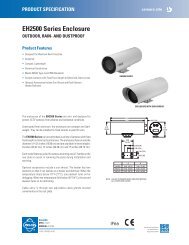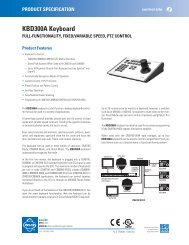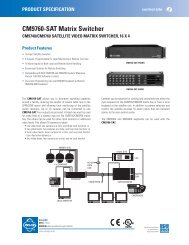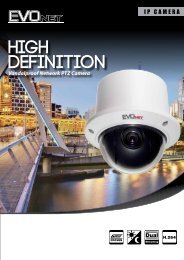Chapter 1 - Pacific Communications
Chapter 1 - Pacific Communications
Chapter 1 - Pacific Communications
Create successful ePaper yourself
Turn your PDF publications into a flip-book with our unique Google optimized e-Paper software.
Network Video Recorder<br />
Master NVR System<br />
• Master, Slave: Select Master. It allows you to watch or search<br />
video of this NVR system and slave NVR systems (maximum<br />
7) registered on this NVR system. The NVR system runs as a<br />
master NVR system by default and this setting will be used when<br />
the NVR system has been run as a slave NVR system and you<br />
want to change it back to a master NVR system.<br />
1. Click the OK button in the bottom.<br />
2. Enter the ID and password of the master NVR system.<br />
3. The recording and streaming services of this NVR system, which<br />
have been registered on the master NVR system, are restored to<br />
this NVR system. When the recording and streaming services<br />
are restored, devices which are not registered on the recording<br />
service are deleted and device related settings such as device<br />
groups and usage of the streaming service for monitoring video<br />
from a device, etc. are all reset and you have to check all the<br />
settings and set up again.<br />
Slave NVR System<br />
NOTE: When you change back the NVR system which has been run as a slave NVR system to a master<br />
NVR system, devices which are not registered on the recording service are deleted and device related settings<br />
such as device groups and usage of the streaming service for monitoring video from a device, etc. are all<br />
reset and you have to check all settings and set up again. If necessary, write down the current device related<br />
settings and save it in a separate place before setting the slave NVR system.<br />
• Master, Slave: Select Slave. This NVR system is registered<br />
on the master NVR system and it allows you to watch or search<br />
video of this NVR system in the master NVR system.<br />
− Master: Enter the IP address and port number of the master<br />
NVR system. If the master NVR system uses the DVRNS<br />
function, selecting Use DVRNS allows you to enter the master<br />
NVR system’s name registered on the DVRNS server instead<br />
of the IP address. You can check the name in the master NVR<br />
system’s DVRNS setting (connect to the master NVR system<br />
→ click the (System Setup) button in the Service menu of<br />
the SiRiS Setup program → click DVRNS).<br />
− Slave: If this NVR system uses the DVRNS function, no settings are required. If this NVR system<br />
does not use the DVRNS function, enter the external IP address of this NVR system. If the external<br />
IP address is not correct, you may not watch or search video. If you want, you can change the DVRNS<br />
settings of this NVR system (click the (System Setup) button in the Service menu → click DVRNS).<br />
1. Click the OK button in the bottom.<br />
2. Enter the ID and password of the master NVR system.<br />
3. The recording and streaming services of this NVR system are registered on the master NVR system.<br />
The devices registered on the recording service are registered together.<br />
4. This NVR system reboots.<br />
23
















